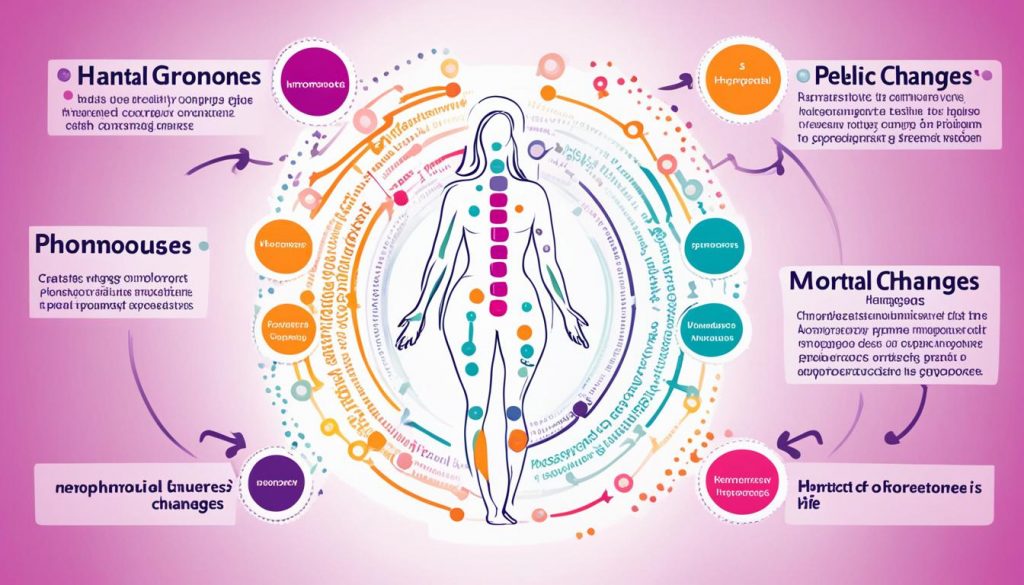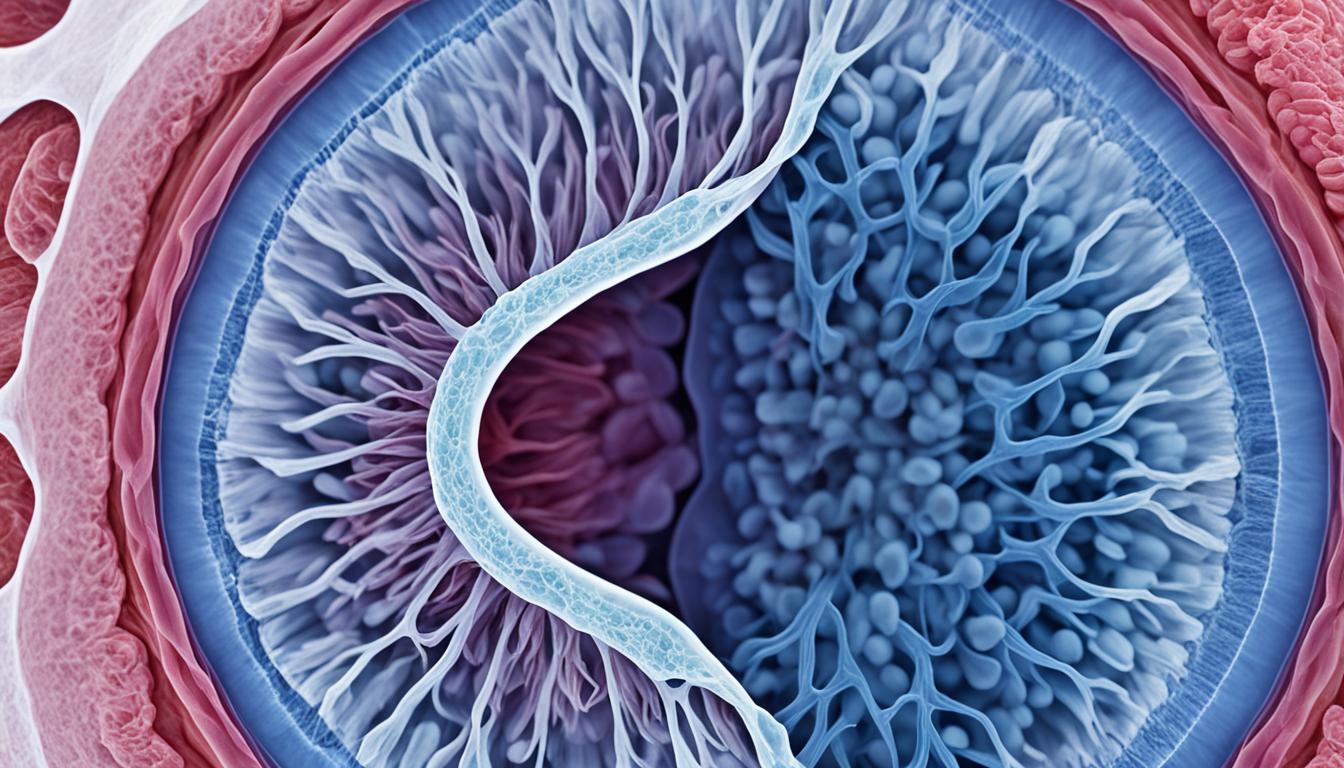Bladder prolapse is a condition that happens when the bladder moves from where it should be. It’s usually because the connective tissue in the vagina’s front wall gets weak or hurt. This issue can make people feel really uncomfortable and cause other problems. In the next part, we’ll look at what causes bladder prolapse, its symptoms, how to know if you have it, and a new treatment involving stem cells.
Key Takeaways:
- Bladder prolapse is a condition where the bladder descends or shifts from its normal position due to weakened or damaged connective tissue in the anterior wall of the vagina.
- Symptoms of bladder prolapse include pain and discomfort in the pelvic area, urinary tract disorders, low back pain, pain during sex, and a sensation of a tumor in the vagina.
- The main causes of bladder prolapse are obesity, menopause, carrying heavy objects or stress, pregnancy and childbirth, and other factors such as genetics, chronic cough, and constipation.
- Diagnosis of bladder prolapse typically involves a pelvic examination, medical history evaluation, and possibly imaging tests to assess the extent of prolapse.
- Treatment options for bladder prolapse vary depending on the severity and may include pelvic floor exercises, vaginal lifts, estrogen therapy, or surgery.
- Stem cell therapy is an emerging treatment option that shows promise for repairing and strengthening the damaged tissues in bladder prolapse.
Types of Pelvic Prolapse
Pelvic prolapse appears in different forms, impacting various organs in the pelvis. It leads to a variety of symptoms and complications. Knowing about these types is key to diagnose and treat this condition well.
Uterine Prolapse
Uterine prolapse is one kind, where the uterus drops into the vagina. This happens when pelvic muscles and ligaments get weak. Reasons include pregnancy, childbirth, obesity, or hormonal changes. It can cause discomfort, pressure, and trouble with bowel movements or peeing.
Cystocele
Cystocele is another pelvic prolapse that involves the bladder dropping into the vagina. It happens when tissues between the vagina and bladder weaken. This causes the bladder to bulge. You might leak urine, need to pee often, and feel like you can’t fully empty your bladder.
Rectocele
Rectocele is when the rectum sticks into the vagina’s back wall. It’s due to weak tissues between the rectum and vagina. This leads to a bulge. Symptoms include difficulty pooping, feeling like you can’t empty well, and needing to press on the vagina to poop.
Vaginal Vault Prolapse
Vaginal vault prolapse happens after a hysterectomy. The top of the vagina drops into the canal because of weak supports. It can make you feel pressure or heaviness and cause discomfort during sex.
Different types of pelvic prolapse need careful checking and treatment plans. If you have symptoms, see a healthcare professional for proper diagnosis and treatment advice.
Causes and Risk Factors of Pelvic Prolapse
Pelvic prolapse happens due to many factors. Knowing these causes helps in taking steps to prevent it.
Childbirth: Having a baby through vaginal delivery is a big risk factor. The pushing during birth can weaken muscles and tissues in the pelvic area. This leads to prolapse. Having many babies or a very big baby can make it worse.
Hormonal Changes: Changes in hormones during menopause can also cause prolapse. When estrogen levels drop, pelvic tissues can get weaker and less flexible.
Aging: Getting older can weaken pelvic floor muscles and tissues. This makes it harder for them to hold pelvic organs in place.
Chronic Conditions: Long-term conditions like a constant cough, being overweight, and constipation can stress pelvic floor muscles and tissues. This stress can lead to prolapse. A constant cough increases pressure in the abdomen, obesity puts extra weight on the pelvic floor, and constipation causes straining during bowel movements.
Genetics: Your genes can affect your risk of pelvic prolapse. If your family has a history of it, your risk may be higher.
| Causes of Pelvic Prolapse | Risk Factors |
|---|---|
| Vaginal childbirth | Multiple pregnancies |
| Hormonal changes during menopause | Prolonged labor |
| Aging | Chronic cough |
| Chronic conditions (obesity, constipation) | Genetics |
Dealing with these causes and risk factors can lower the chance of getting pelvic prolapse. Staying healthy, having good bowel habits, and treating long-term conditions are important. Doing pelvic floor exercises like Kegels can also strengthen muscles and support pelvic organs.

Taking these preventative steps and getting medical help early can greatly help people at risk or who already have pelvic prolapse.
Symptoms, Diagnosis, and Medical Evaluation of Pelvic Prolapse
Pelvic prolapse can lead to symptoms that affect how well you live. Knowing these symptoms and getting checked out fast are key. Some symptoms you might notice include:
- A bulging feeling in the pelvic region
- Discomfort or pressure in the vagina
- Urinary incontinence or going to the bathroom a lot
- Trouble emptying the bladder
- Pain during intercourse
- Lower back pain or pelvic discomfort
To figure out if it’s pelvic prolapse, see a gynecologist. The check-up starts with your medical history. This helps the doctor understand your symptoms and any past health issues. Then, you’ll have a pelvic exam to check the position of your pelvic organs.
Doctors might also use imaging tests in the diagnosis process. Here’s what they could use:
- Ultrasound: This test uses sound waves to get pictures of the pelvic organs. It shows how severe the prolapse is and if there are other problems.
- Magnetic Resonance Imaging (MRI): This gives detailed images of the pelvic area. It helps in knowing how bad the prolapse is and checking for other issues.
Assessments of the pelvic floor are also done. They check how strong your muscles are and how well your pelvic floor works. This information helps decide the best treatment for you.
Diagnosing Pelvic Prolapse: A Comprehensive Approach
Finding out if it’s pelvic prolapse calls for looking at symptoms, exams, and tests. This complete check ensures doctors understand the problem fully. It allows them to make a treatment plan that meets your needs.
Note: In the next section, we will explore the available treatment options for pelvic prolapse, including both non-surgical and surgical approaches.
Treatment, Prevention, and Conclusion
Treatment for pelvic prolapse depends on its severity. Non-surgical methods can help. This includes pelvic floor exercises, changing certain lifestyle habits, and using pessaries. These steps aim to strengthen the pelvic muscles. They help support the pelvic organs. This can reduce the discomfort from pelvic prolapse.
In severe cases, surgery might be needed. This is when other treatments don’t bring relief. Surgical options like colporrhaphy, sacrocolpopexy, or hysterectomy are available. They aim to fix or give back support to the pelvic organs. Surgery is considered after a full talk with a doctor. This also requires looking closely at the patient’s condition.
Preventing pelvic prolapse is key. It helps in managing and reducing the risk. Keep a healthy weight and do pelvic floor exercises often. Avoid lifting heavy things. Also, manage conditions like constipation well. Taking these steps helps prevent pelvic prolapse or keep it from getting worse. Consulting healthcare professionals is vital. They offer guidance suited to each person’s needs.
FAQ
Q: What are the symptoms of bladder prolapse?
A: Symptoms include pelvic pain, trouble with peeing, and lower back pain. You might feel pain during sex. There’s also a feeling of a lump in the vagina.
Q: What causes bladder prolapse?
A: It’s caused by many factors like being overweight, hormonal changes, and lifting heavy things. Pregnancy, childbirth, family history, a persistent cough, and constipation also play a role.
Q: How is bladder prolapse diagnosed?
A: Doctors diagnose it with a medical exam. This may involve checking the pelvic area, ultrasound or MRI, and pelvic floor tests.
Q: What are the treatment options for bladder prolapse?
A: Treatments vary based on its severity. They can be pelvic exercises, vagina supports, hormone therapy, or surgery.
Q: What are the types of pelvic prolapse?
A: Types include uterine, bladder (cystocele), rectal prolapse, and vaginal vault prolapse.
Q: What are the causes and risk factors of pelvic prolapse?
A: Causes are vaginal childbirth, menopause, getting older, and ongoing health issues. Being overweight and genetics are also factors.
Q: How is pelvic prolapse diagnosed?
A: It’s found through a check-up. This includes a pelvic exam, imaging tests like ultrasound or MRI, and exams of the pelvic floor.
Q: What are the treatment options for pelvic prolapse?
A: Options might be pelvic floor exercises, changes in lifestyle, and using supports. Surgery is considered if needed.
Q: How can pelvic prolapse be prevented?
A: To prevent it, keep a healthy weight, do pelvic exercises, avoid lifting weights. Managing ongoing conditions and getting the right medical care helps too.

